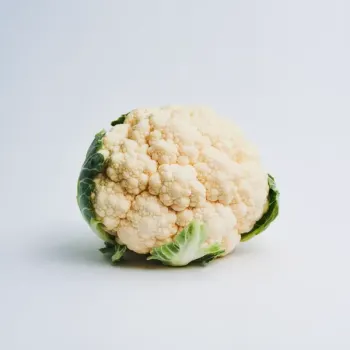Broccoli and cauliflower are popular cruciferous vegetables often compared in cooking for their unique flavors, textures, and nutritional benefits, influencing how each is best prepared and served in dishes.

Broccoli is a green vegetable from the Brassica family, known for its tree-like structure with tightly clustered florets atop stalks. It's celebrated for its dense nutritional profile and earthy, slightly bitter taste.

Cauliflower is a white, sometimes purple, green, or orange, vegetable, also from the Brassica family. It has a milder, sweeter taste than broccoli and its florets form a dense head, similar to that of broccoli but without the green pigment.
While both vegetables share a similar shape and texture, broccoli is green and has a more pronounced flavor compared to the subtler, nuttier taste of cauliflower. Broccoli also contains more vitamins like vitamin K and A, whereas cauliflower provides higher levels of vitamin B-6.

Your ultimate Recipe Box, Meal Planner, and Cooking Class all in one
Steamed broccoli is a classic side dish, often served with a sprinkle of salt or a drizzle of olive oil. Its vibrant color and slightly crunchy texture make it a favorite for retaining its nutritional value. Steamed cauliflower can be seasoned with herbs and spices to enhance its flavor. It's great for purees or soups due to its creamy texture when cooked.
Roasted broccoli, with its crispy edges and savory taste, pairs well with garlic and parmesan. It makes a robust side that stands up to hearty flavors. Cauliflower becomes caramelized and sweet when roasted. It's perfect as a vegetarian steak or when seasoned with turmeric and other warm spices.
Raw or blanched broccoli adds a crunchy texture to salads. It's ideal in a broccoli salad mixed with bacon, cheese, and a creamy dressing. Cauliflower can be used raw, pickled, or lightly steamed in salads. Its softer texture is perfect in a Mediterranean-style salad with olives and feta.
Both broccoli and cauliflower are low in calories and high in fiber, making them great for a healthy diet.
| Nutrient | Broccoli ( per 100g ) | Cauliflower ( per 100g ) |
|---|---|---|
| Fat | 0.4g | 0.3g |
| Protein | 2.8g | 1.9g |
| Calories | 34 | 25 |
| Vitamin C | 89.2mg | 48.2mg |
| Vitamin K | 101.6mcg | 15.5mcg |
| Carbohydrates | 6.6g | 5g |
Yes, they can often be used interchangeably, but consider the flavor and texture differences when doing so.
Both are healthy options, but broccoli has more vitamins K and A, while cauliflower is higher in vitamin B-6.
Absolutely! Both stems are edible and can be peeled and enjoyed raw, steamed, or stir-fried.
Both should be stored in a refrigerator. Keep them in a loose plastic bag with a paper towel to absorb moisture.
Yes, their low carbohydrate content makes them suitable for a ketogenic diet.